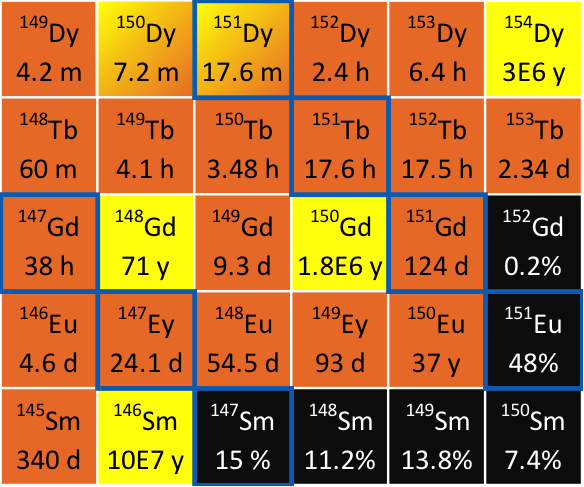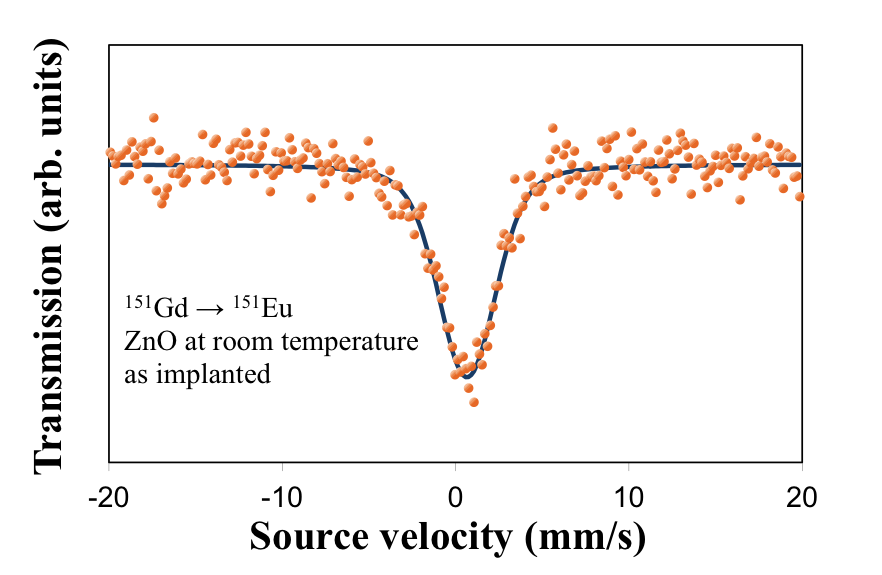ISOLDE: New access to study dilute rare earth doped materials
Mössbauer spectroscopy (MS) is named after Rudolf L. Mössbauer (1929-2011) who found the effect in 1957 and was awarded the Nobel Prize in Physics for his discovery in 1961. MS makes use of recoilless nuclear resonance fluorescence of gamma rays from low energy nuclear states and has found applications in many disciplines of science with 57Fe being the most applied Mössbauer isotope/probe.
The spectral energy resolution (tenths of nano-eV) is sufficient to resolve the hyperfine interactions, i.e. splitting/shift of nuclear levels due to the electronic configuration of the Mössbauer probe atom. It gives fundamental information on the probe atom at the atomic-scale that is either inaccessible or impossible with other techniques such as valence state and site symmetry of the probe atom and on magnetic interactions. In addition the implantation of the radioactive probe atom (emission MS (eMS)) one can study “truly” dilute dopant concentrations (i.e. <0.1 at.%) where precipitation and interactions between probe atoms is avoided.
EMS was one of the first techniques to be used for applied science at ISOLDE, with emphasis on studies in material science and more recently in biophysics [1].
Now for the first time at ISOLDE 151Eu eMS has been achieved. This experiment was performed in parallel to ISOLDE experiment IS528 [2] which utilises emerging radionuclides for medical applications (imaging and therapy). Different terbium isotopes were obtained by decay of laser ionized dysprosium precursors produced by spallation in a proton irradiated tantalum target. Similarly the samples for Mössbauer spectroscopy measurements were implanted with beams of 151Dy which decays to the Mössbauer state of 151Eu, see Fig. 1.

Fig.1: Relevant part of the nuclei chart. 151Dy decays (95%) to 151Gd which decays to the Mössbauer state of 151Eu.
The exact beam composition was investigated using the multi-reflection time-of-flight mass separator from ISOLTRAP (MR-ToF MS) [3], which indicating that ~70% was the nucleus of interest 151Dy. The choice of 151Eu for eMS is to tailor the optical properties of the host of great interest for a wide range of photonic applications such as photovoltaics, sensors, fluorescent bio-labels, fibre-optic communications and more.
Doping using ion-implantation, is furthermore an attractive method, as the doping can be done in a non-thermodynamic equilibrium. However, the ion-implantation process causes damages to the host material, and annealing procedures are needed to repair the material.
The first result shown in Fig. 2 is the spectrum obtained after implantation into single crystalline ZnO at room temperature. Only a single line at the centre due to Eu3+ is observed and the intensity indicates that the Gd/Eu atom is incorporated into the lattice (i.e. not at an interstitial location). However, the line width is almost three times wider than expected. The most likely explanation is that this is due to non-equal environments of the probe atoms as a consequence of the implantation damage. The Eu probe atoms are located on the same lattice site, but with slightly different non-perfect lattice environments. Alternatively, it is possible that the larger Gd/Eu atoms simply do not fit onto regular lattice sites in the ZnO lattice. In the next few months, before the Gd decays, this will be investigated and we will determine the annealing temperature and conditions needed to obtain a defect free environment (if possible).

Fig.2: First 151Eu emission Mössbauer spectrum of implanted ZnO at room temperature obtained at ISOLDE.
In conclusion, a new technique for the investigation of dilute rare earth dopant atoms in materials pursuing fundamental physics is now available at the ISOLDE facility, and results from first test beams are being produced.
Acknowledgement:
UK + KJ + TEM + FW + ISOLDE collaboration
References
[2] http://cds.cern.ch/record/1387984
[3] Wolf et al., Int. J. Mass Spectrom. 349, (2013) 123-133
